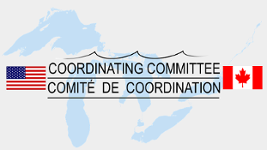Major accomplishments of the Vertical Control – Water Levels Subcommittee include the establishment of the International Great Lakes Datum (IGLD) 1955 and the revised IGLD 1985. Revisions to the datum are required due to the continued effects of crustal movement, new surveying methods, and the deterioration of the zero reference point gauge location. Additionally, vertical movement is studied to provide an estimate of the change expected between the published dynamic heights related to IGLD and true dynamic heights continuously changing with time. This helps planning for upgrades of the datum, such as IGLD 2020, coming in the near future.
The Vertical Control – Water Levels Subcommittee also works extensively on water level gauging activities. The National Oceanic and Atmospheric Administration (NOAA) operate 53 gauges in the Great Lakes – St. Lawrence River basin; the Canadian Hydrographic Service (CHS) operates 34 gauges; and the Corps of Engineers operates 18. Coordination on all elements required for a quality gauging station is continuous. The Subcommittee has also published the “History of Water Level Gauges” for the basin. These reports document the history of the operation of water level gauges on the Great Lakes and their outflow rivers including locations, bench marks, relocations and maps.
The Hydraulics Subcommittee has documented methods for conducting hydraulic field measurements of discharge in the Great Lakes connecting channels. Discharge data for the connecting channels of the Great Lakes are important data elements in all studies of levels and flows and can be derived using different methods. As such, consistency and coordination in the collection of these data sets are important. The maintenance of a database of discharge measurements is under way and reports documenting all sites at which discharge measurements had been made in the past have been created. The report includes location maps, measurement techniques, computation methods, water level readings and tables of the discharges.
The Hydraulics Subcommittee also coordinates continuous time series of flow values for the St. Clair, Detroit and Niagara Rivers. Ice and weed retardation values required for regulation and hydraulic routing models of the long term water levels of the Great Lakes are also coordinated. Hydraulic modelling data are coordinated by the Subcommittee. Methodologies and standards for modelling for international studies are agreed upon and modeling efforts continue for all connecting channels and the St. Lawrence River.
The Hydrology Subcommittee spends a great deal of effort in coordinating forecasted water levels for the Great Lakes. It is important that there is one coordinated information base issued to the public so there is not confusion about which set of numbers an individual should use. The actual data values that make up the forecast bulletins are coordinated as well as the graphics and text on the document itself.
Many individual pieces of hydrometeorology data that go into the forecasting process are also coordinated to ensure the same base of information is being used for all work. Monthly mean water levels, outflows, precipitation and net basin supplies are all discussed. These data are also used in many Great Lakes studies.
Occasionally, additional ad hoc Subcommittees are formed in order to accomplish certain tasks. An ad hoc group has been created to oversee the re-development of a consistent model to simulate the regulation and routing of outflows and levels in the Great Lakes to be used by all agencies. Another ad hoc group had previously been created to assist in the updating of coordinated physical data for the Great Lakes basin. The group looked at drainage areas, shoreline lengths, lake volume and depths and general dimensions, storage capacities and basin delineations. Many of these data themes were analyzed in the past, but due to emerging technologies, the resultant physical data from recent analyses were more accurate. Having the data available for use in a geographic information system base was also an excellent improvement.
Last revised: 2017-09-27
 Great Lakes Coordinating Committee
Great Lakes Coordinating Committee